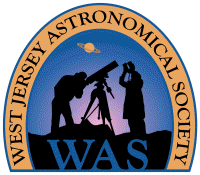| Weather Links |
Mercury 2022 |
Lunar X
|
Total Lunar Eclipse from Cape May
November
8, 2022
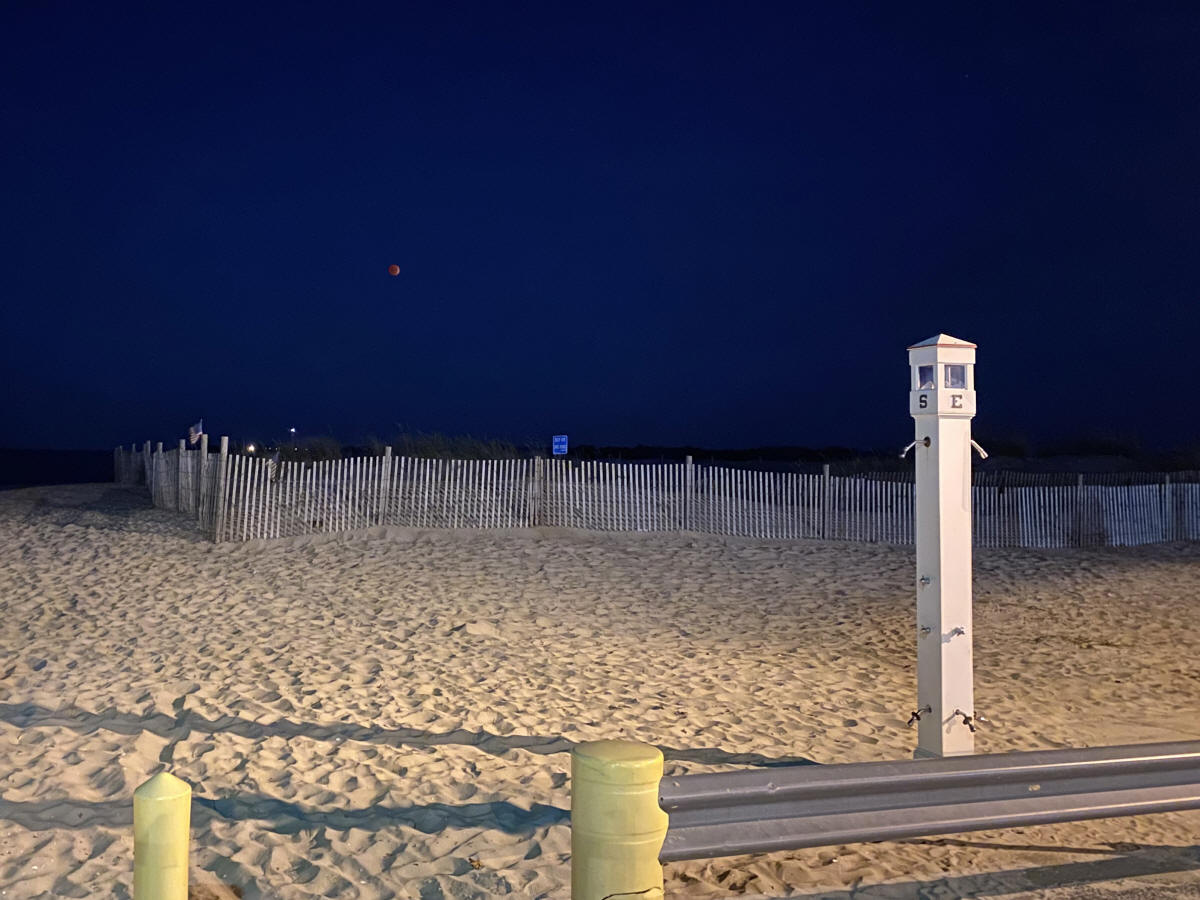
|
A Total Lunar Eclipse
was
visible from New Jersey on
November 8, 2022, so a couple of friends and
myself went to Cape May, NJ, to observe it. Except for a few
snapshots of the locale at the west end of Beach Ave, taken with
my iPhone 11, I just observed visually with unaided eyes and
15x56 binoculars. The image above was captured at 5:45 am EST
(handheld; 1/8 sec, f/1.8, ISO 100) about a third of the way
through totality and shortly before the middle of twilight
(astronomical twilight began at 5:04 am, sunrise would be at
6:35 am). At the time of the picture, the Moon was about 9°
altitude and 284° azimuth. Mouseover for a labeled close-up
crop of the moon. The foreground illumination was provided
by the abundance of artificial lighting at the west end of Beach
Ave, some of which is visible in
this snapshot
looking south from the same spot.
I arrived at Cape May at 3:11 am EST, ten
minutes after
first penumbral contact. By 3:30 am, the upper part of the
moon seemed slightly darkened, but it's hard to tell if it was
due to the veil of cloudiness which was present towards the moon
during the entire eclipse, but never enough to obscure it
completely. At 3:42 am, I saw a
bright meteor, about mag -2.x
(brighter than Mars, perhaps as bright as Jupiter, but not as
bright as Venus, the nominal threshold for being considered a
fireball). It followed an approximate 15° long, nearly vertical
path starting to the right of the Moon and descending. It
fragmented at the end. Perhaps a Northern Taurid? I continued to
watch the Moon with unaided eyes and my 15x56 binoculars as it
entered the umbra at 4:09 am, after which a vague, coppery red
color was evident in the shadowed portion. The reddish color
became more prominent as totality arrived at 5:16 am, but in
general, the eclipsed moon seemed dark; however, this could have
been due to the veil of cloudiness that was always present
and/or the low altitude, about 14° and dropping, at the start of
totality. The eclipsed moon was last seen sometime between 6:00
and 6:15 am with 15x56 binoculars as it disappeared in the
brightening morning twilight (sunrise would be at 6:35 am, the
moon would set at 6:41 am and totality would end at 6:42 am).
In addition to the eclipse, I wanted see the ISS (International
Space Station) and the CSS (Chinese
Space Station, Tiangong).
Heavens-Above predicted the ISS would appear out of the earth's
shadow at 5:26.5 am,
just below the
Pleiades, heading on a path
that went just above Betelgeuse and reach a very bright
magnitude -3.3. Indeed, I saw a relatively dim ISS with 15x56
binoculars just before it emerged from the shadow. However, my
main interest was to spot the
Cygnus freighter heading to the ISS
and trailing behind it by an unknown amount (it launched from
Wallops the previous morning, Monday, Nov 7, but I failed to
spot the ascending Antares rocket due to clouds; Cygnus was
scheduled to dock the next day, Wed, Nov 9). After watching the
ISS with unaided eyes for a fraction of a minute, I went back
under the Pleiades with the 15x56s and saw the relatively dim
Cygnus about a minute behind the ISS. I've spotted the Cygnus
previously, and it seemed a little dimmer than before. I
subsequently learned that one of its solar panels failed to
deploy, so it had less reflective surface than usual, but the
remaining panel still generated enough power to accomplish the
mission.
While checking on the ISS at Heavens-Above, I also noticed there
was a CSS pass coming out of the earth's
shadow near Mars at 5:10.6 am and it would also be bright,
reaching magnitude -2.2 (new segments were added to it in
October, so its size increased). The CSS appeared right on
schedule. |
Venus (& Mercury) in the Daytime
October 10 to November 14, 2022
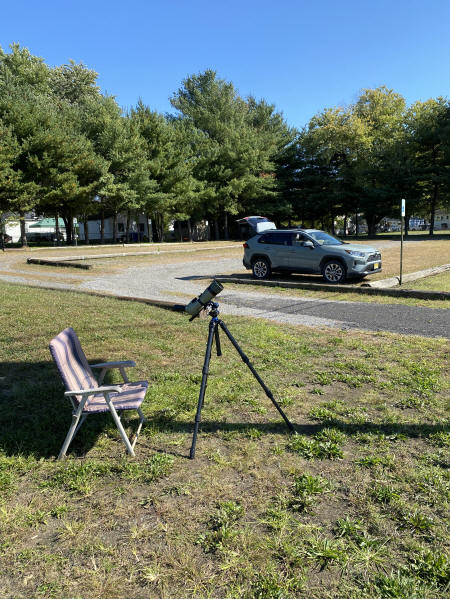
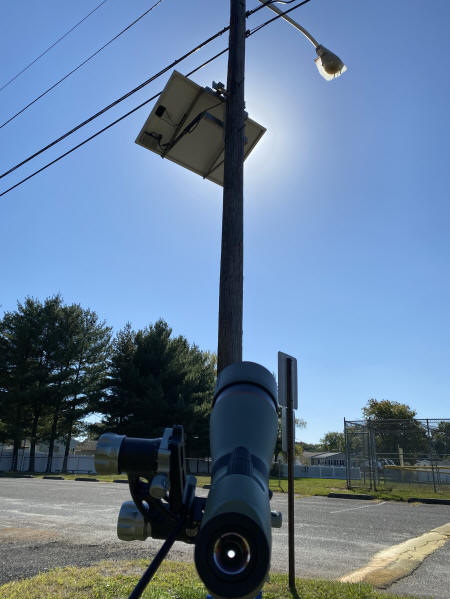
|
As Venus
approaches superior conjunction on October 22, 2022, it is moving
closer to the Sun such that Sky & Telescope's
This Weeks Sky at a Glance, October 7 - 15 says in the planet roundup that "Venus is lost in the glare of
the Sun." Such proclamations have never stopped me from looking,
and indeed, I spotted Venus on
October 10, 2022, at 1:43 pm EDT (43.2°
altitude) with my 88 mm apo spotting scope from the Maple Shade,
NJ, baseball field complex. It was found at 25x then increased
to 60x to better show the 9.8 arc second disc.
It was followed until 2:05 pm (41.4° altitude). During that
interval,
Venus was 3.4° west of the Sun,
center-to-center (the Sun has a nominal 16 arc minute
semi-diameter, so about 3.1° between Venus and the
solar limb). Venus was not found with 15x56 binoculars nor was
it found in the photo on the right, even when magnified with brightness
and contrast adjustments.
Of course, looking that close to the sun without a filter on
the scope requires special precautions.
Even though Venus was quite bright at magnitude -3.9, any filter
strong enough to block the Sun would also render Venus invisible
in the bright daytime sky. Therefore, some opaque obstruction is
needed to block the Sun, in this case one of the ubiquitous
solar panels found on utility poles in this area (the setup is
shown in the photos above from Oct 10). Despite the
clear, deep-blue sky, Venus still presented low contrast near
the bright aureole of glow around the Sun. One must keep the
scope in the Sun's shadow, progressively moving it as the apparent Sun moves across the sky.
Update:
Venus was also spotted during the day
at the baseball field complex on October 14 at 1:33
pm (2.5° from the sun, center-to-center), October 15 at 2:50 pm (2.2°),
October 18 at 11:35 am (1.6°),
October 19 at 12:11 pm (1.4°), October 20
at 11:20 am (1.25°), October 21 at 11:46 am (1.13°) and
October 22 at 12:42 pm (1.06°
center-to-center or 47.4 arc minutes limb-to-limb).
Superior conjunction is at 5:17 pm EDT (21:17 UT) on October 22,
4 hr 20 min after after it was last seen on Oct 22 at 12:57 pm. Sighting Venus today, October 22, the
day of superior conjunction, complements my sighting of it on
January 8, 2022, the day of inferior conjunction.
Update October 27:
After four days of gloomy weather since superior conjunction,
the sky on October 27 was clear and deep blue. Mercury was
sighted before sunrise, then I went to the Maple Shade baseball
field complex around noon and spotted Venus with the 88 mm
spotting scope at 25x at 11:39 am EDT when it was 1.53° east of
the sun, then examined it at 60x to confirm the 9.7″ diameter
disc. Using Venus as a starting point, I then found Mercury with
at 12:05 pm with the 88 mm scope at 25x and confirmed the 5.0″
disc at 60x (more details on
my Mercury page). Finally, I took advantage of the blue sky
to spot the young crescent moon, 2.2 days old and 6.6%
illuminated, about 30° east of the sun with the 88 mm scope at
25x. I subsequently found it with 10x42 binoculars.
On October 29, under a clear blue sky, I spotted Venus from my
front yard in Maple Shade, NJ, with my 88
mm spotting scope at 25x, then 60x to confirm the disc
(and using my house to block the Sun). Venus 1.94° from the sun,
center-to-center. On October 30, November 2 & 3, Venus was again
spotted from the front yard with the 88 mm scope at 25x, then
increased to 60x to confirm the disc. On Oct 30, it was 2.2°
from the sun, on Nov 2, 2.8° and Nov 3, 3.1° from the sun.
Mercury was last seen in the daytime on November 3 before
superior conjunction on November 8.
Update November 14:
After spotting Venus a number of times during the daytime since
November 3, on November 14, I was able to use Venus to find
Mercury around 11:15 am from my front yard (under a clear blue sky).
Both were now east of the sun, Venus about 5.8° and Mercury
about 3.6°. That was my first post-conjunction sighting of
Mercury and therefore the first sighting of the current evening
elongation. At sunset, I went to Swede Run to attempt Venus
post-sunset. I picked it up at 4:50 pm EST, six minutes after
sunset when it was at 2.0° altitude, using my 88 mm apo spotting
scope at 25x, confirming the disc at 60x. The ecliptic's angle
to the horizon was relatively shallow at 33.6°, but at least
Venus was at +1.6° ecliptic latitude. I did not attempt to find
lower-altitude Mercury. |
Mercury in Virgo
October 6, 2022
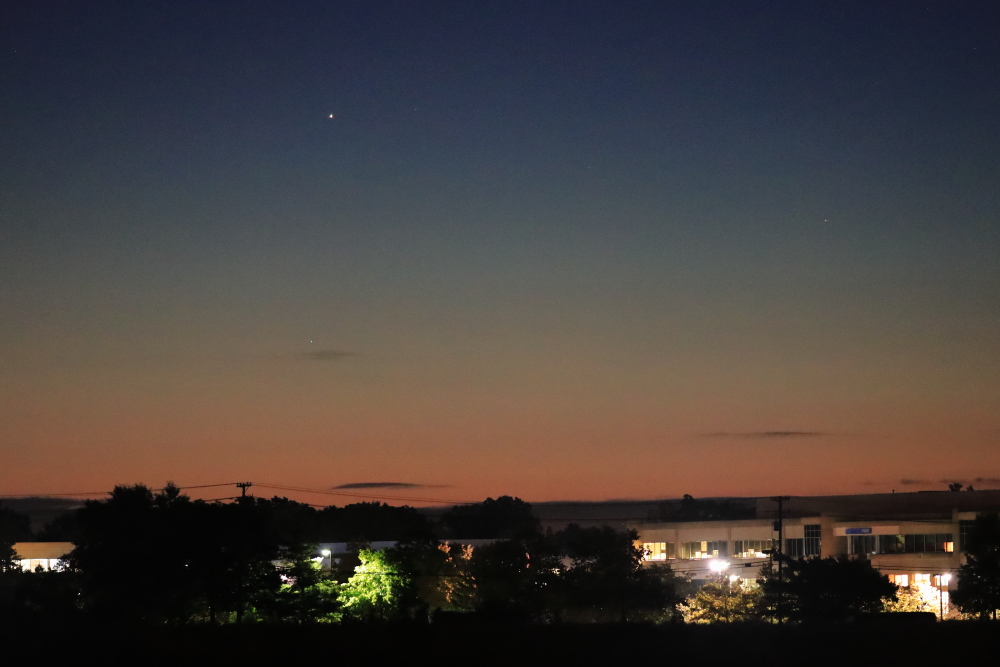
|
After nearly a week of clouds and rain from the stalled remnants
of tropical storm Ian, the weather cleared and the planet
Mercury
was spotted at 5:39 am EDT on
October 6, 2022, with 8x42
binoculars from Marter Ave in Mt Laurel, NJ, when it was at 1.1°
altitude in the constellation
Virgo. This was the first sighting of the 75th elongation in
a row that I've spotted
Mercury. It was seen with unaided eyes at 5:42 am (1.7°
altitude). The snapshot above was taken at 5:55 am EDT
(4.1° altitude) with a Canon EOS RP DSLM camera and a Canon
200
mm f/2.8L telephoto lens on a fixed tripod. It's a single raw
frame exposed 1/6 second at f/2.8, ISO 12,800. The raw image was mildly adjusted,
cropped to 77% of the original linear dimensions for a field
7.9° wide x 5.3° high and then converted to a JPEG in
Canon's Digital Photo Professional 4.
Mouseover for labels. |
Saturn in Capricornus
August 3, 2022
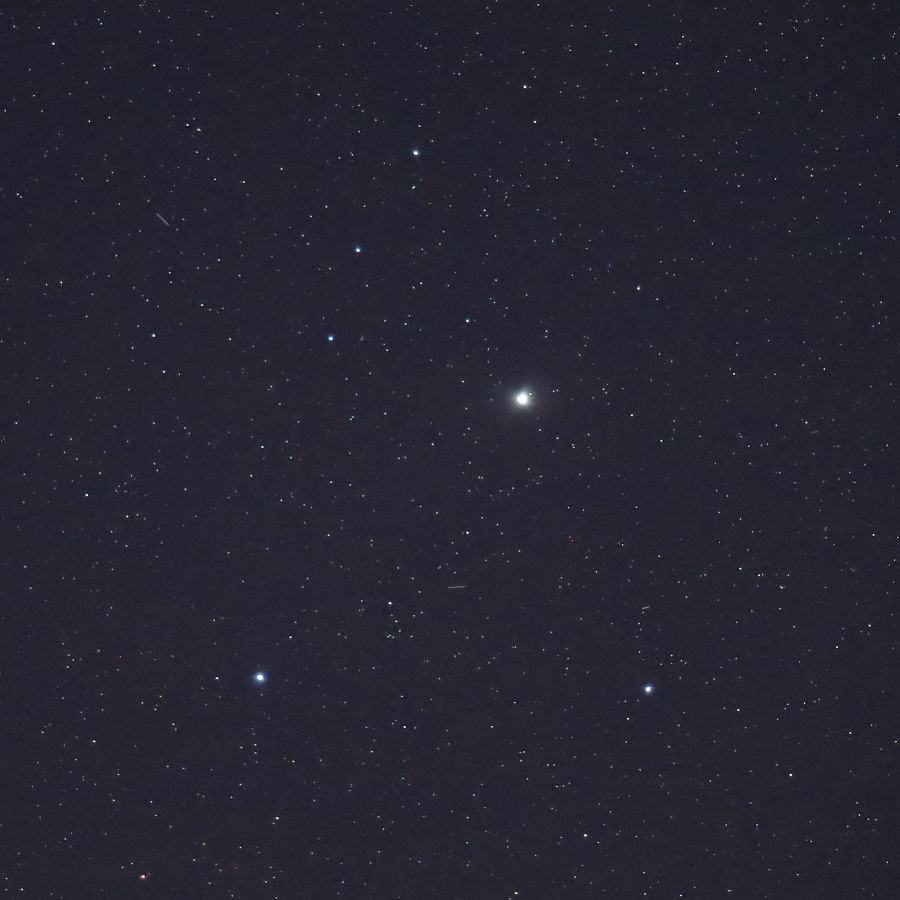
|
The planet Saturn
is currently at the eastern end of the "bikini bottom" stick
figure of the constellation
Capricornus. This snapshot of it was taken at 12:57 am EDT
on
August 3, 2022, from Wharton State Forest in the New Jersey Pines with a Canon EOS RP DSLM camera and a Canon
200
mm f/2.8L telephoto lens on a Sky-Watcher Star Adventurer
equatorial mount (tracking, but not guided). It's a single raw
frame exposed 8 seconds at f/2.8, ISO 3200. The raw image was mildly adjusted,
cropped to a 4.0° square field and converted to a JPEG in
Canon's Digital Photo Professional 4.
Mouseover for labels; parenthetical numbers represent the
magnitude, with the decimal point omitted for the stellar values.
Nominally, north is up, east is left. Note that a couple of
short satellite streaks were also captured.
Here are
some more
images from this session.
At the moment, Saturn, Deneb Algedi and Nashira form a compact,
nearly equilateral triangle as viewed with unaided eyes. These
objects, plus 42, 44 and 45 Capricorni, are close enough to
provide a splendid view with most binoculars. Saturn will
continue retrograde (westward) movement past opposition on
August 14 until it's stationary again on October 23, when it
resumes direct (eastward) movement, about 3.8° west of Nashira. |
Venus at Swede Run
July 10, 2022
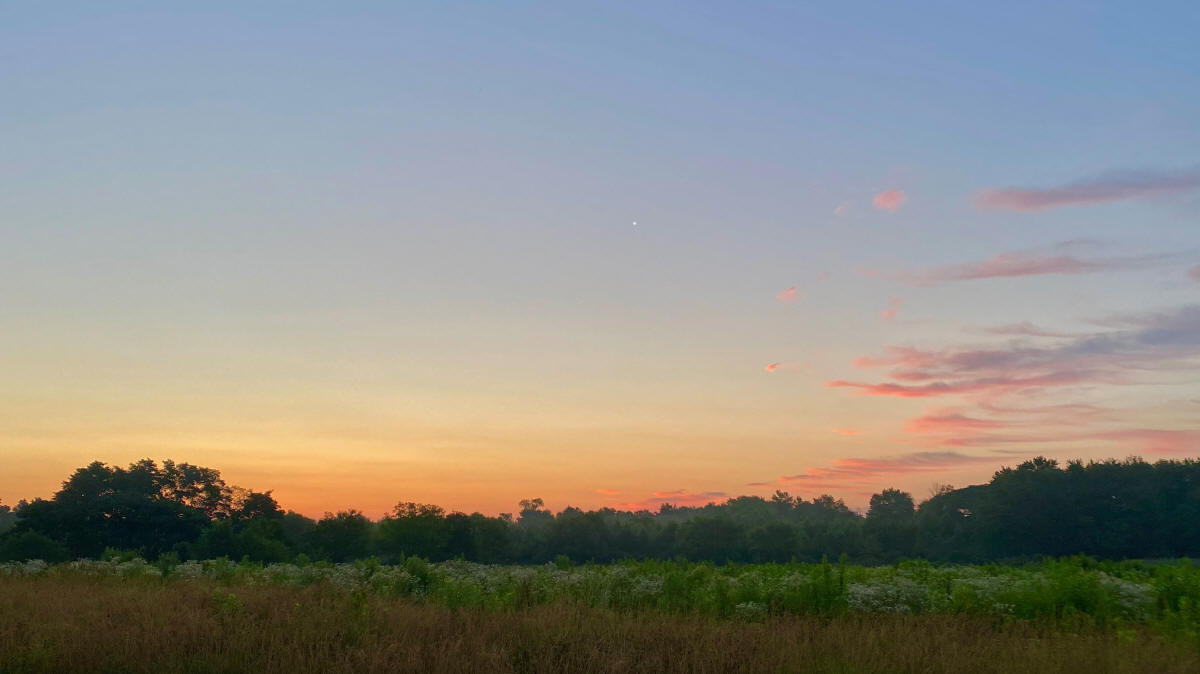
|
On Sunday morning,
July 10, 2022, I went to
Swede Run in Moorestown NJ, for some general observing with
unaided eyes and 15x56 binoculars. I arrived about 3:45 am EDT
and left about 5:30 am. Astronomical twilight began at 3:41 am
and sunrise was at 5:40 am. Before I left, I took this snapshot of
the view to the east at 5:25 am with an iPhone 11. It was not my
intention to capture Venus, I mostly wanted to document the
position of Mercury at the treetops when seen between 5:17 and
5:26 am. Later, when examining the enlarged picture, I noticed
Venus, which at magnitude -3.9 can be seen in bright twilight
with relative ease. At 5:25 am, Mercury was at 3.5° altitude,
Venus at 17.5° altitude.
This snapshot was adjusted with Apple's
Photo app on my iPad, then cropped to a 16:9 ratio with Adobe
Photoshop Elements, which I also used to brighten Venus with the
dodge tool. I could not find any sign of magnitude -1.6 Mercury
in the photo; it's not only dimmer than Venus, but it was
situated in brighter
twilight through a murky sky along the horizon. Mouseover
for labels showing the positions of these inner planets.
While there, I also observed all of the
planets, Venus,
Mars,
Jupiter and
Saturn with
unaided eyes, Mercury,
Uranus and
Neptune, plus
the minor planet/asteroid (4) Vesta,
with 15x56 binoculars. One of my objectives,
spotting Mercury,
was prompted by Sky & Telescope's "This Week's Sky at a Glance,
July 8 - 16," which indicated "Mercury
is out of sight in conjunction with the Sun" (Mercury is at
superior conjunction on July 16). This was taken as
a challenge. While there, I also looked at the long-period
variable star, Mira (Omicron Ceti)
which is approaching a maximum. Because of passing clouds, I
never got a good view of comparison stars, but I guesstimated it
was around magnitude 3 to 4 (recent
estimates at AAVSO).
Then at 4:08 am, I saw a bright fireball, about magnitude -6
(decidedly brighter than Venus), which traversed a horizontal
90° path from below Mars to below the Little Dipper, around 35°
altitude, over the course of 3 to 4 seconds.
A report was filed at the American Meteor Society. |
Barnard's Star, V2500 Oph
July 3, 2022
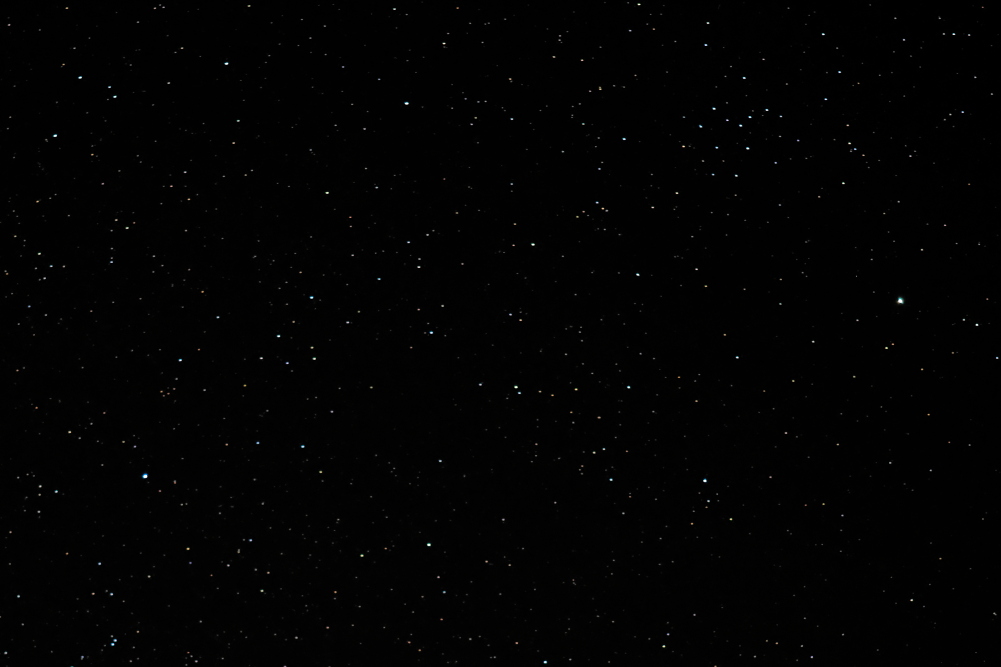
|
Here's Barnard's Star,
V2500 Ophiuchi, on
July 3, 2022, as seen from the
WAS's
Barnegat Rd Observing Site in the New Jersey Pines. It was also
observed visually with 15x56
binoculars. This snapshot of it was taken at 11:40 pm EDT with a Canon EOS RP DSLM camera and a Canon
200
mm f/2.8L telephoto lens on a fixed tripod. It's a single raw
frame exposed 2 seconds at f/2.8, ISO 12,800. The raw image was mildly adjusted in Canon's Digital Photo
Professional 4, cropped to 51% of the original linear
dimensions for a field
5.3° wide x 3.5° high and finally converted to this JPEG.
Mouseover for a label.
Barnard's Star is notable because it's a red dwarf that's
only 5.9 light years from the solar system, such that for
observers at 40°N latitude, it is the
nearest star after the Sun. Additionally, it
has the greatest known stellar
proper motion, about 10.3 arc seconds per
year. In the past couple of decades, I've been able to detect a
small displacement in its position. |
Comet C/2017 K2 (PANSTARRS)
July 3, 2022
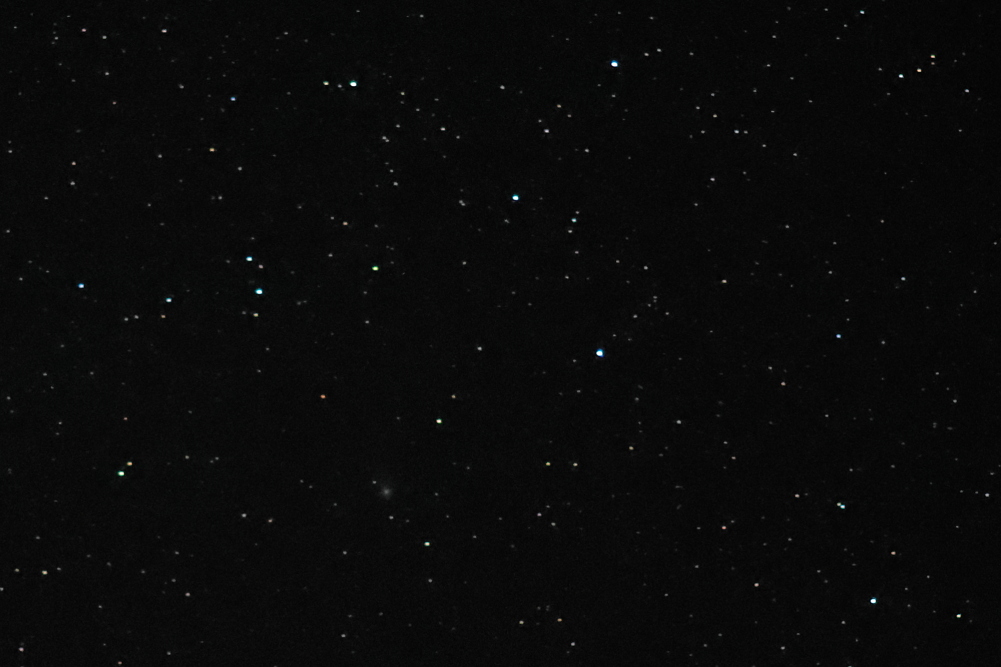
|
On the evening of
July 3, 2022, the relatively bright comet,
C/2017 K2 (PANSTARRS),
was observed from the
WAS's Barnegat Rd Observing Site in the
New Jersey Pines. The sky was about as good as it gets in New
Jersey with billowing Milky Way visible from the Summer Triangle
down through Sagittarius.
This comet, about
magnitude 8 at the time, was seen visually with 15x56
binoculars and a 115 mm spotting scope; this snapshot of it was
captured at 11:36 pm EDT. Taken with a Canon EOS RP DSLM camera and a Canon
200
mm f/2.8L telephoto lens on a fixed tripod. It's a single raw
frame exposed 2 seconds at f/2.8, ISO 12,800. The raw image was mildly adjusted in Canon's Digital Photo
Professional 4, cropped to 32% of the original linear
dimensions for a field
3.3° wide x 2.2° high and finally converted to this JPEG. As pictured, K2 was about 7° southwest of
Cebalrai (Beta Oph) at 51°
altitude, 182° azimuth.
Mouseover for a label.
There was a proper astrophoto of this comet
posted in the Spaceweather Photo Gallery. It was
taken at very nearly
the same time from the Southern Hemisphere, so it's rotated
180° with respect to my snapshot (here's a
copy of the SW photo rotated to match the Northern
Hemisphere view). Note that Z Oph towards the tip of the tail is
distinctly orange in the SW photo.
On both the evenings of
July 14 and July 15, 2022, C/2017 K2 will pass about
half-a-degree from globular cluster M10, which in turn is 3¼°
from globular cluster M12, so all three of them should fit
simultaneously in a typical binocular field. K2 will make its
closest approach to earth on July 14, then perihelion is on
December 19, 2022. |
Foggy Mercury
July 1, 2022
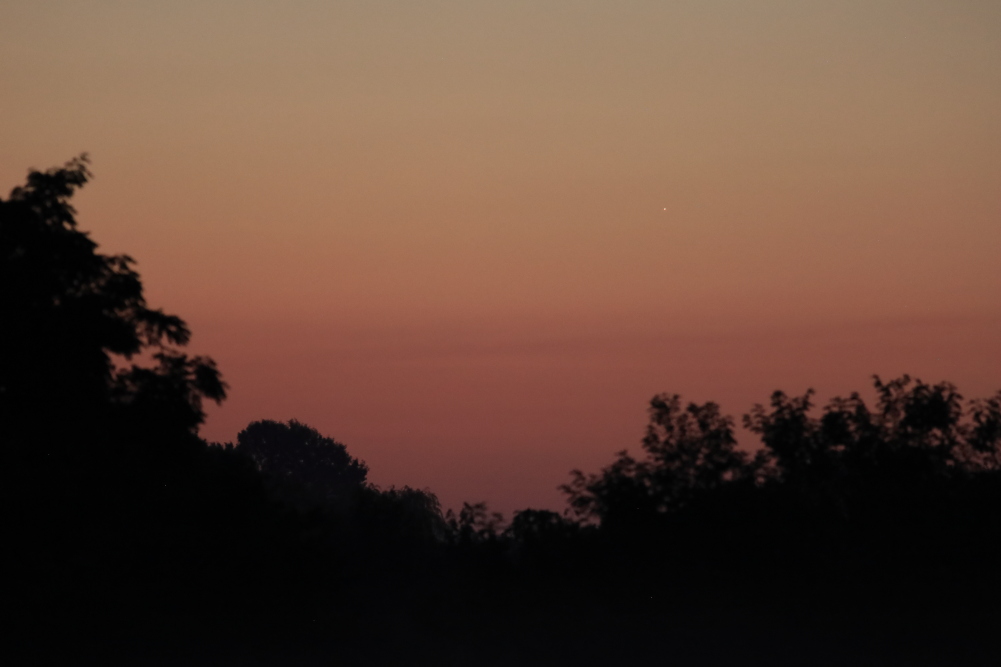
|
On the morning of
July 1, 2022, the innermost planet
Mercury
was spotted in morning twilight from Swede Run in Moorestown,
NJ. This snapshot of it was taken through ground fog
at 4:46 am EDT
with a Canon EOS RP DSLM camera and a Canon
400
mm f/5.6L telephoto lens on a fixed tripod. It was exposed 1/6 second at
f/5.6, ISO 3200 and slightly adjusted in Canon's Digital Photo
Professional 4. It's uncropped for a field
5.1° wide x 3.4° high. At the time, Mercury was at 3.0°
altitude. Astronomical twilight started at 3:33 am and sunrise
would be at 5:35 am.
Mercury will be at superior conjunction on July 16.
Mouseover for a label. |
Young Crescent Moon
June 30, 2022
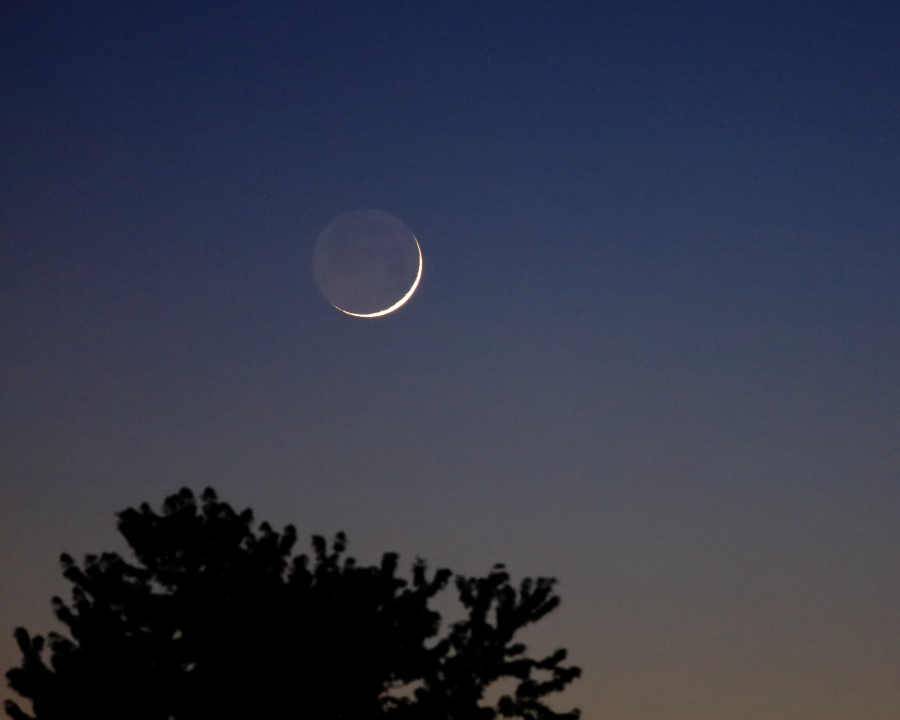
|
On
June 30, 2022, following its passage last week
along the line of morning planets, the 3.3% illuminated,
2-day-old
Crescent Moon
with earthshine was plainly evident in the evening twilight
towards northwest after sunset. This snapshot of it was taken at
9:30 pm EDT from Collins
Lane Park in Maple Shade, NJ, with a Canon EOS RP DSLM camera and a Canon
400
mm f/5.6L telephoto lens on a fixed tripod. It was exposed 1/8 second at
f/5.6, ISO 3200 and mildly adjusted in Canon's Digital Photo
Professional 4. It's cropped to 77% of the original width x 92%
of the original height (to a 5:4 ratio) for a field
4.0° wide x 3.2° high. At the time, the Moon was at 6.0°
altitude; sunset was at 8:33 pm and astronomical twilight would
end at 10:35 pm. |
Planetary Lineup
June 19, 2022
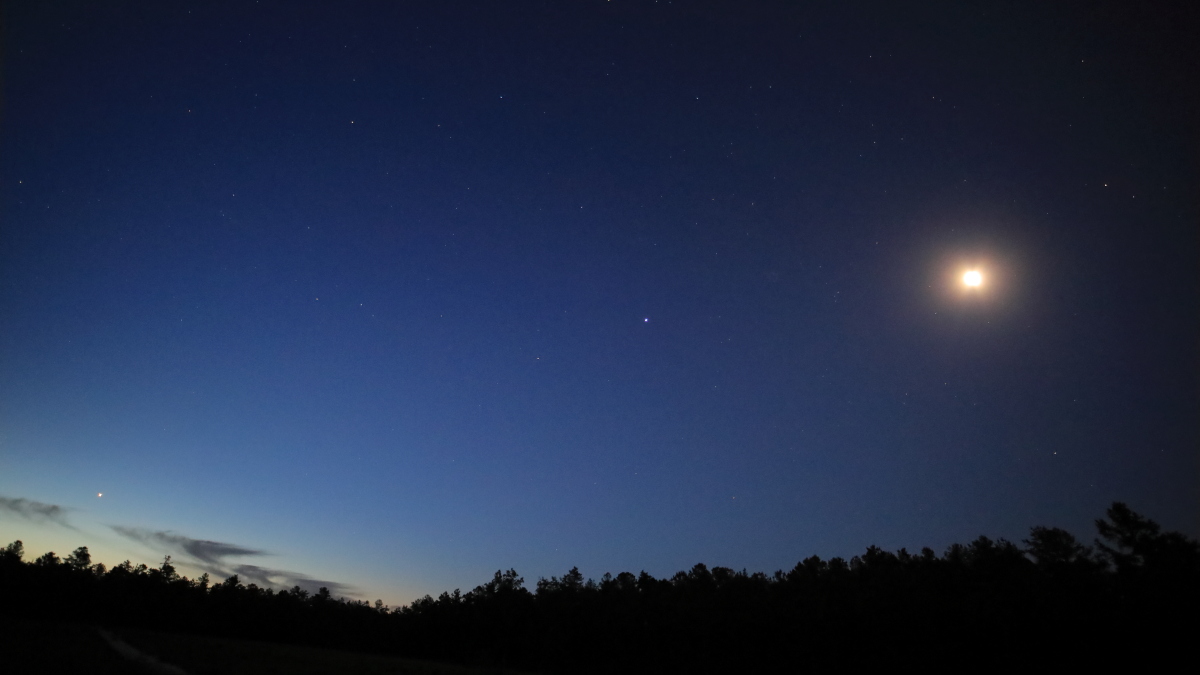
|
On
June 19, 2022, I went to Wharton State Forest,
NJ, to observe the lineup of planets in morning twilight. This
"Planet Parade" is described in a
Sky & Telescope press release and in a
Bob King article at S&T. Except for a few streaky
clouds along the eastern horizon, the sky was quite clear and the temperature was refreshingly cool, 55°F, with no
dew.
On arrival at 3:49 am EDT, 21 minutes after the start of
astronomical twilight, I was able to immediately see
the planets
Saturn,
Jupiter
and
Mars, as well as the 69%
illuminated waning gibbous
Moon, with unaided eyes. At 3:52
am, I picked up magnitude 7.9
Neptune
with 15x56 binoculars and at 3:58 am, brilliant
Venus
appeared at the treetops (3.1° altitude). I needed my 88 mm apo spotting scope
to find the magnitude 7.2 minor planet/asteroid,
(4) Vesta, which was only about
1.5° from the bright Moon (center-to-center). Magnitude 5.8
Uranus
was spotted at 4:14 am with the 15x56s, and finally, magnitude
+0.3
Mercury
was found just above the treetops with the 15x56s at 4:41 am. I
was able to periodically glimpse Mercury with unaided eyes from about 4:44 to
4:50 am.
I could still see Mercury, Mars and Saturn, but not Uranus,
Neptune or Vesta, at 5:00 am with the 15x56s, when I started
packing up in bright twilight. Venus, Jupiter and the Moon were still visible with
unaided eyes as I pulled off the field at 5:10 am. Sunrise was
at 5:30 am.
The image above was captured at 4:24 am, before Mercury appeared
and before twilight became too bright. Mouseover for labels.
The brighter major planets and the Moon are labeled in white
while the
locations for
dimmer objects that can't be seen are labeled
in gray, with circles indicating the approximate positions.
Taken with a Canon EOS RP full-frame DSLM camera and an
Irix 15
mm f/2.4 Firefly lens. It's a single raw frame exposed 0.5
seconds at f/2.4, ISO 6400 (automatic exposure -1 stop). It was
lightly adjusted in Canon's Digital Professional Photo 4 and
cropped vertically to a 16:9 ratio for a field 100.2° wide by
68.0° high
Update, June 25-26:
Overnight, I again saw all the planets and the Moon as listed
above using as needed my unaided eyes or 15x56 binoculars. Additionally, I saw the dwarf
planet (134340) Pluto and the comet C/2017 K2 (PANSTARRS) with
my 16-inch Newtonian reflector and the
International Space Station with unaided eyes.
Here's a timeline tabulation. |
Recurrent Nova U Scorpii
June 9, 2022
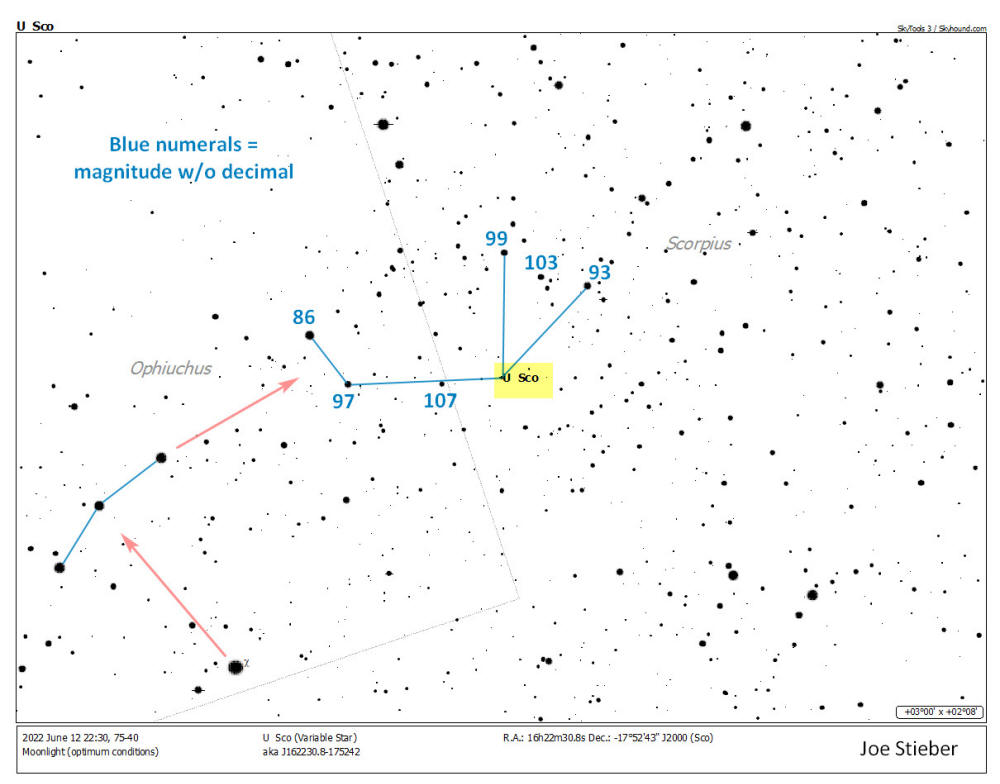
|
A
Bob King article at Sky & Telescope online alerted me to the
recent outburst of recurrent nova,
U Scorpii. On
June 9, 2022, the weather finally permitted me
to take a look at it, albeit with a 75% illuminated moon in the
sky and some thin passing clouds low in the south, between 10
and 11 pm EDT. From my suburban backyard, I initially tried with
my 88 mm apo spotting scope and I was able to glimpse it, but
the view of U Sco and the surrounding field stars was marginal,
so I switched to my 115 mm apo spotting scope, which at 50x, provided an
unambiguous view.
I found U Sco by star hopping from χ
(Chi) Ophiuchi as shown by the rose-colored arrows I added to
the SkyTools chart above. I labeled the nearby field stars with
their magnitude in blue (omitting the decimal points) for
comparison. It appeared that U Sco was between the magnitude 9.7
and 9.9 stars, so my non-expert estimate was magnitude 9.8. At
the time, visual estimates at AAVSO were running from 9.7 to
10.5. As of this writing on June 11,
the latest visual estimates at AAVSO are running beyond
magnitude 11, so it is fading as expected. I'll try again on the
next clear night to see it again before it disappears.
Update: I went to
Atsion in Wharton State Forest on
June 17, 2022, for
a follow-up observation. Using the 115 mm apo spotting scope at
70x, I was able to see nearby field stars down to about
magnitude 12 around 10:45 pm (astronomical twilight ended at
10:32 pm EDT), but did not see a star at
U Sco's
position. AAVSO estimates were around magnitude 13 at the time. |
A Surprise Visitor
May 21, 2022
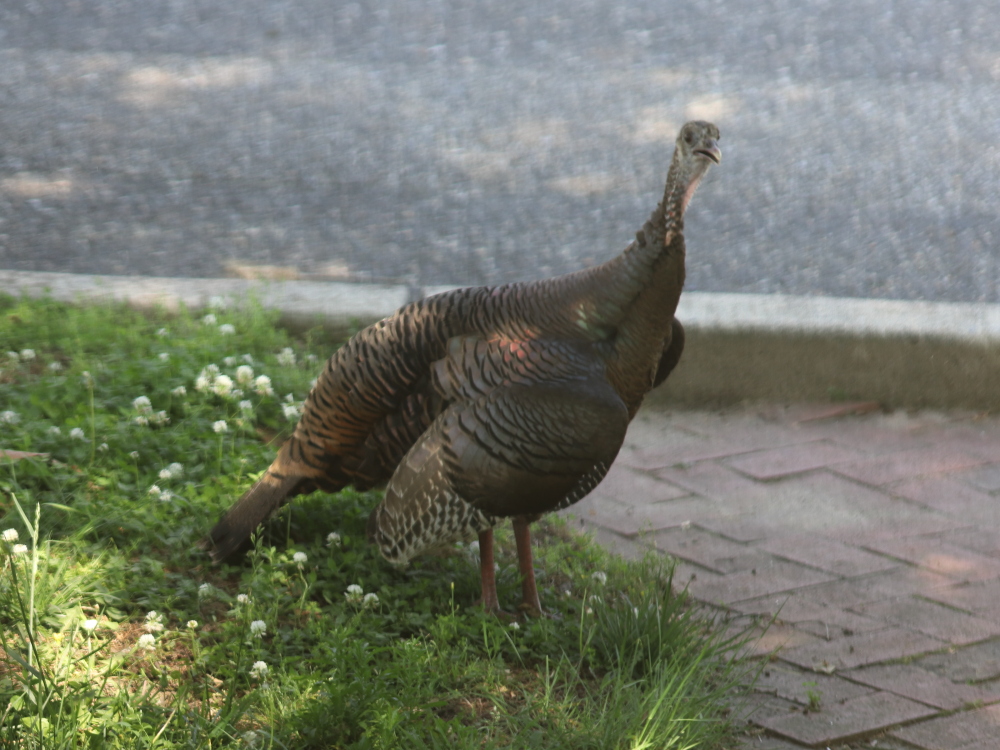
|
On
May 21, 2022, I looked out the small window on
my front door (then through the storm door window) and much to
my surprise, there was a
Wild Turkey hanging out in my front yard in very
suburban Maple Shade, NJ. It was an unusually warm day with the
temperature about 95°F at the time. Based on the plain
coppery-brown color (which showed some iridescence in sunlight)
and the absence of a red wattle, I presume this is a hen. Taken
through the windows at 3:36 pm EDT with a handheld Canon
EOS RP DSLM camera and a Canon 200 mm f/2.8L lens. It was a
fully automatic exposure, 1/400 second at f/2.8, ISO 200. No
processing was applied, but it's cropped to 67% of the original
width x 76% of the original height (to a 4:3 ratio) for a field
6.9° wide x 5.2° high. I frequently see wild turkeys in the
Pines, but this the first time in Maple Shade. Mouseover for
a wider view taken several minutes earlier with an iPhone
11. Note the small bird left of the tree at the edge of the
bricks. That's a Mockingbird, a type frequently seen in the
yard.
The previous evening,
May 20, 2022, as I was driving home from pizza
after the WAS
meeting, a
Red Fox trotted across Maple Shade's Main St in front of me.
I slowed down for a good look and it looked back
at me before darting into the nearby shrubbery (around 11:15
pm). |
The Crescent Moon, Mercury and Aldebaran
May 2, 2022
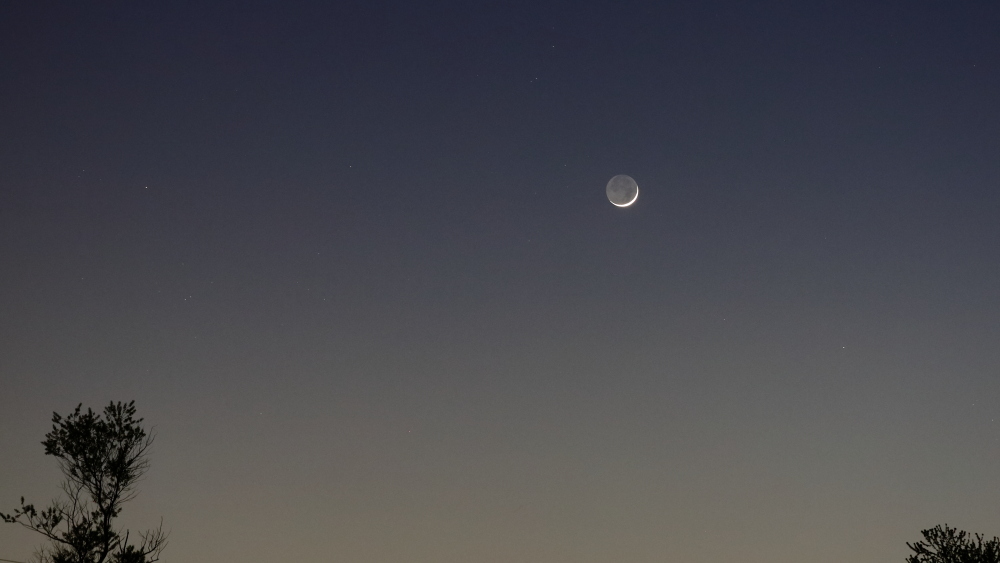
|
After sunset on
May 2, 2022, the
Crescent Moon
joined the planet
Mercury
and the bright star
Aldebaran,
all in the constellation
Taurus the Bull. This image was taken at 8:55 pm EDT from Collins
Lane Park in Maple Shade, NJ, with a Canon EOS RP DSLM camera and a Canon
100
mm f/2.8L macro lens on a fixed tripod. It was exposed 0.5 seconds at
f/4.0, ISO 1600 and mildly adjusted in Canon's Digital Photo
Professional 4. It's cropped to 77% of the original width x 65%
of the original height (to a 16:9 ratio) for a field
15.7° wide x 8.9° high. Mouseover for labels.
Mercury was initially sighted at
8:17 pm with 15x56 binoculars about 4° below right of the
Crescent Moon and was seen with
unaided eyes at 8:34 pm
(sunset was at 7:56 pm). At 8:20 pm using an 88 mm apo spotting
scope at 60x, it displayed a thick crescent as seeing permitted.
The sky was cloud free, but transparency wasn't
great. Aldebaran was visible with
unaided eyes, but other stars in the Hyades required the
binoculars to see (with difficulty). A couple of the
Pleiades were seen with binoculars,
but all of them required the spotting scope. |
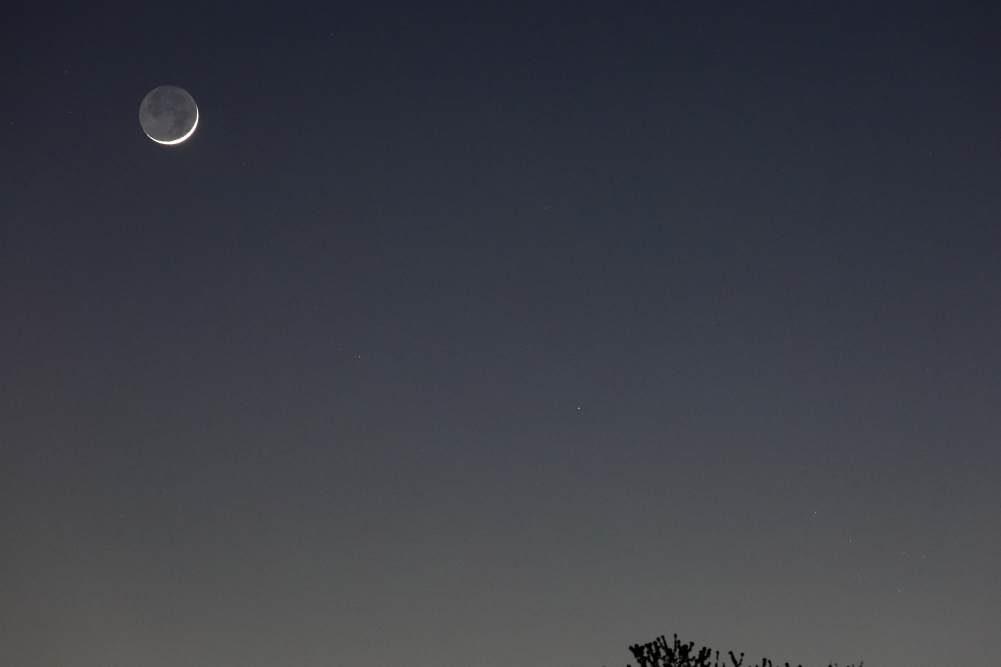
|
Another picture of the
Moon and
Mercury, plus
the
Pleiades star
cluster, was taken at 9:00 pm EDT with
the same Canon EOS RP DSLM camera, but a Canon 200
mm f/2.8L lens on a fixed tripod. It was exposed 0.5 seconds at
f/4.0, ISO 1600 and mildly adjusted in Canon's Digital Photo
Professional 4. It's cropped to 80% of the original dimensions
(maintaining the 3:2 ratio) for a field 8.2° wide x 5.5° high. Mouseover for labels.
The picture below is the same original frame, but cropped
further to better show Mercury and the Pleiades. |
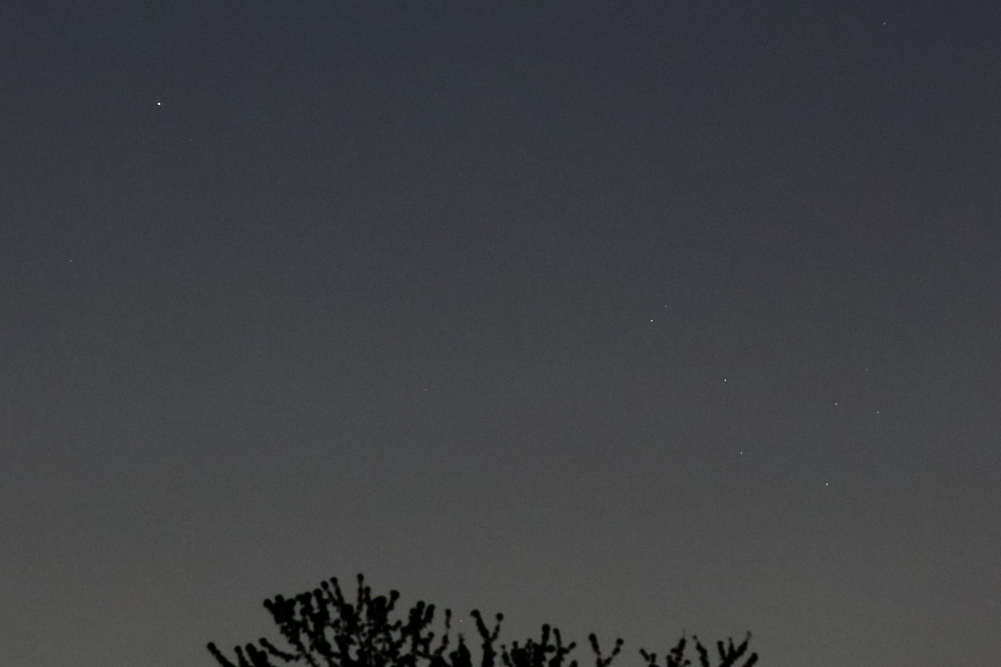
|
This is the same original picture as the
one above taken at 9:00 pm, but to better show
Mercury and
the Pleiades,
it was cropped to 38% of the original dimensions
(maintaining a 3:2 ratio) for a field 4.0° wide x 2.6° high. Mouseover for labels. |
Jupiter and Venus
April 30, 2022
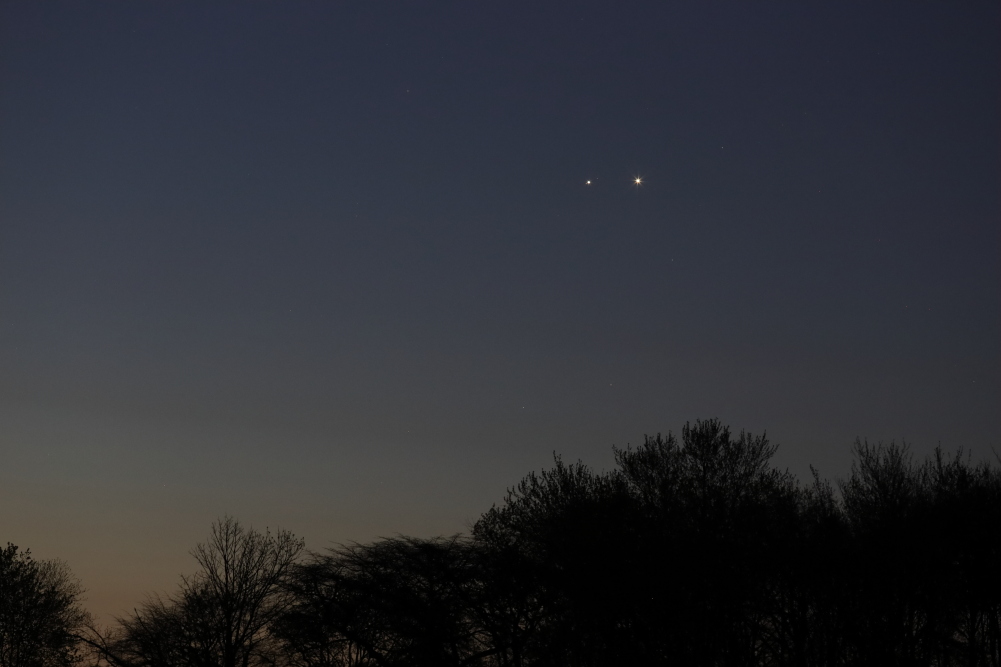
|
On the morning of
April 30, 2022, the two brightest planets,
Jupiter
and Venus,
were only about half-a-degree apart (the nominal diameter of the
moon), or more exactly, 30.9 arc minutes when this picture of
them was captured at 5:00 am EDT from Swede Run in Moorestown,
NJ. Taken with a Canon EOS RP DSLM camera and a Canon 200
mm f/2.8L lens on a fixed tripod. It was exposed 0.8 seconds at
f/4.0, ISO 1600 and slightly adjusted in Canon's Digital Photo
Professional 4. It's uncropped for a field
10.3° wide x 6.9° high. Mouseover for labels.
At the time of the picture, Jupiter
and Venus were at 6° altitude.
Jupiter was 34.6″
equatorial diameter and magnitude –2.1. Venus was 16.8″
diameter, 67% illuminated and magnitude –4.1 (6.3x brighter than
Jupiter). As observed in an 88 mm apo spotting scope at 60x, the
Jovian satellite Ganymede was east of the disc, Io, Europa and
Callisto were west of the disc, but Europa was eclipsed by
Jupiter's shadow and not visible. At 60x, the gibbous disc of
Venus looked like a somewhat rounded football. As a bonus, at
5:15 am, I saw a bright meteor, almost as bright as Jupiter,
pass close to Mars, dropping straight down from the Summer
Triangle high overhead. |
Mercury and the Pleiades
April 29, 2022
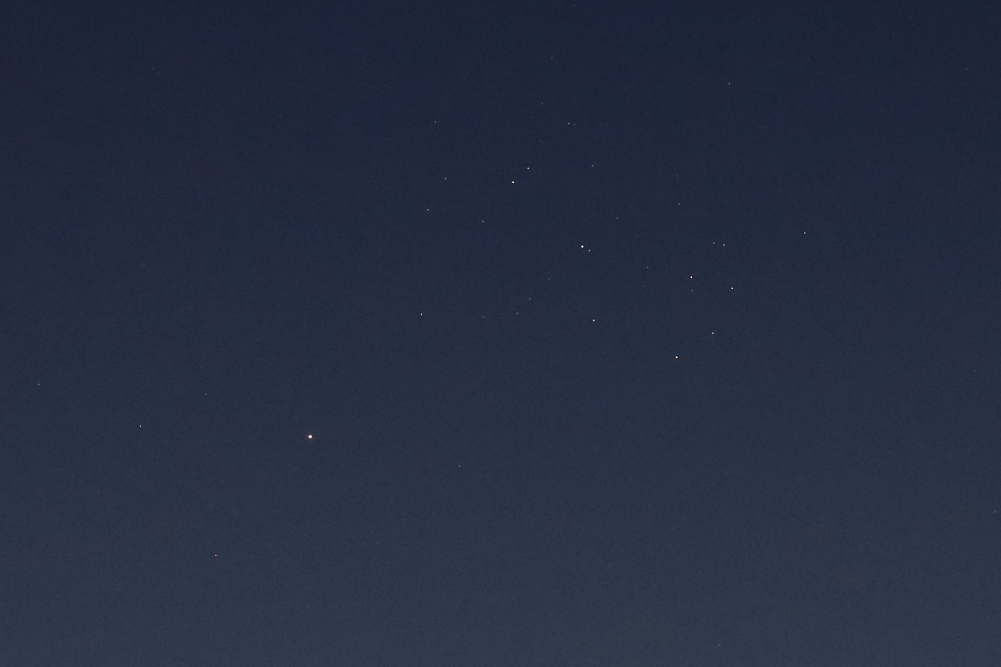
|
The planet Mercury
passed close to the Pleiades
star cluster (Messier 45) on the evening of
April 29, 2022, about 1.4° center-to-center.
This image of them was captured at 8:52 pm EDT from
Collins Lane Park in Maple Shade, NJ. Taken with a Canon EOS RP
DSLM camera and a Canon 200
mm f/2.8L lens on a fixed tripod. It was exposed 0.4
seconds at f/4.0, ISO 1600. It was mildly
adjusted in Canon's Digital Photo Professional 4 and cropped it to
38% of
the original linear dimensions for a field
4.0° wide x 2.6° high. Mouseover for labels.
At the time of the picture, Mercury
was magnitude +0.4, 8° altitude, 8.0″ diameter and 36%
illuminated. Observed with an 88 mm apo spotting scope at 96x,
Mercury appeared to vacillate between the shape of a wiggly
banana and a thick crescent due to seeing fluctuations at the
low altitude. At 25x in the spotter, Mercury and the Pleiades
all fit in the 2.4° field of view, a lovely sight. |
Jupiter, Venus & Mars
April 20, 2022
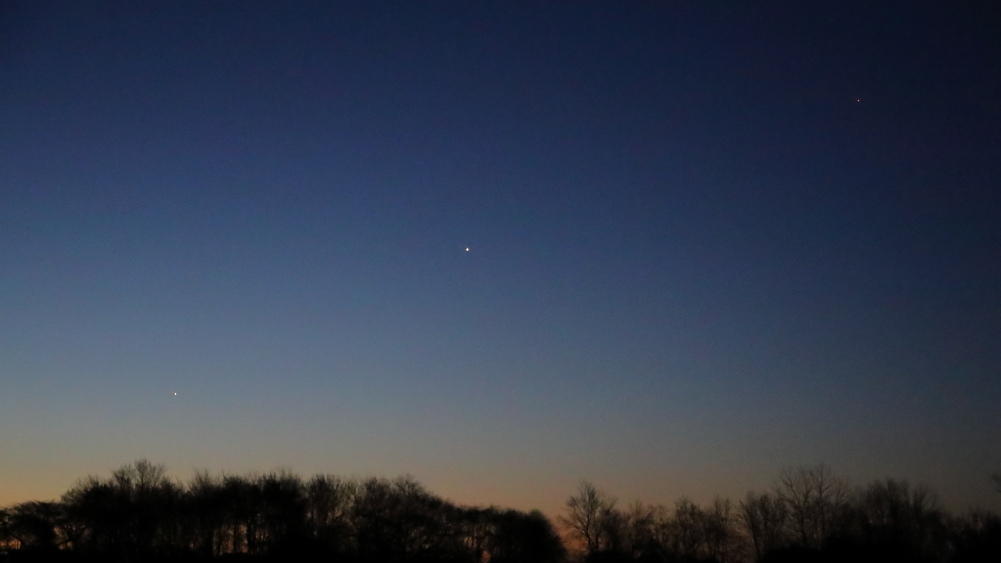
|
This image of Jupiter, Venus and Mars was captured
on
April 20, 2022, at 5:31 am EDT from
Swede Run in Moorestown, NJ. Taken with a Canon EOS RP DSLM
camera on a fixed tripod and a Canon 24 to 105
mm f/4.0L zoom lens set to 65 mm focal length. It was exposed
1/50
second at f/4.0, ISO 12,800, auto white balance. Slightly
adjusted in Canon's Digital Photo Professional 4 and cropped it to
93 x 78% of
the original linear dimensions for a field
28.8° wide x 16.5° high. When I got home and checked my
snapshots, I realized that I failed include Saturn at the
western end of the line of morning planets. Duh! Mouseover for label.
On April 30, Jupiter and Venus will be just half-a-degree apart. |
Mercury
April 19, 2022
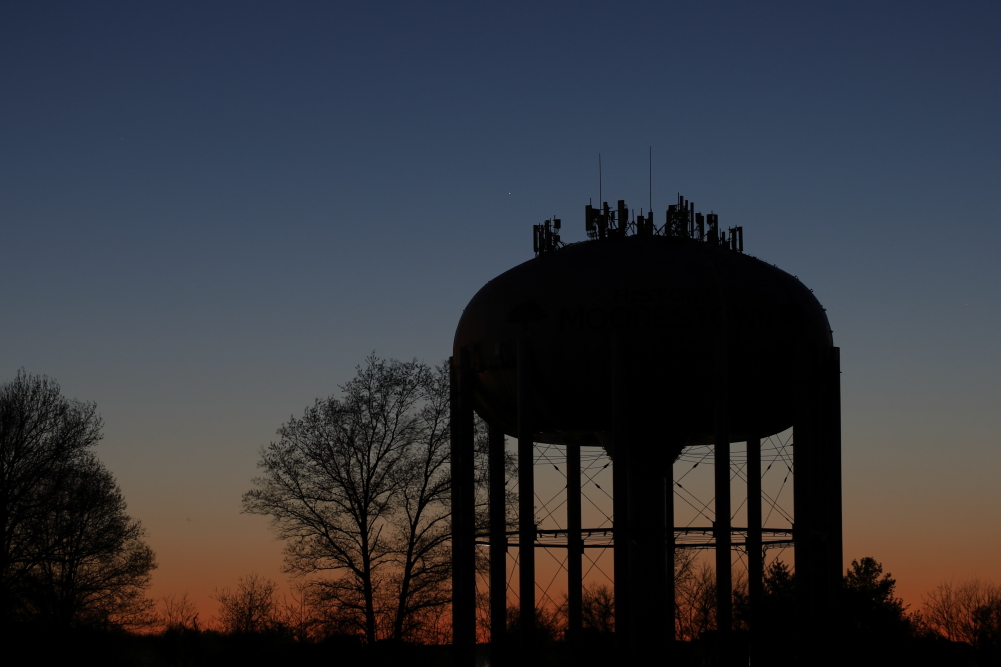
|
On
April 19, 2022, the sometimes elusive planet
Mercury
was observed after sunset, initially at 8:01 pm EDT with 8x42
binoculars, then at 8:07 pm with unaided eyes at Swede Run in
Moorestown, NJ. This was the fifth sighting of the third
elongation for 2022, and this elongation was the 72nd in a row
that I've seen Mercury, starting in January 2011. Here's my
Mercury sighting page for
2022. When initially spotted this evening, Mercury was
magnitude -0.8, 12.5° altitude,
6.2″
apparent diameter and 69% illuminated.
This image with Mercury was captured at
8:25 pm from the "Vegetable Stand" on Church St in Moorestown.
Taken with a Canon EOS RP DSLM camera and a Canon 100
mm f/2.8L macro lens on a fixed tripod. It was exposed 0.4
second at f/4.0, ISO 200, auto white balance. Canon's Digital Photo Professional 4
was used to crop it to 77% of
the original linear dimensions for a field
15.7° wide x 10.5° high, but otherwise, there were no
adjustments. At the time of image capture, Mercury was at 8.2°
altitude. Mouseover for label. |
Click here
for the previous page.
Click here
for an index to all previous SJAstro pages.




















